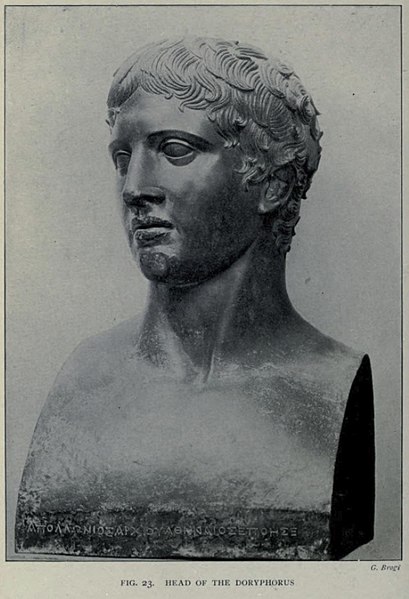The Doryphoros of Polykleitos is one of the best known Greek sculptures of Classical antiquity, depicting a solidly built, muscular, standing warrior, originally bearing a spear balanced on his left shoulder. Rendered somewhat above life-size, the lost bronze original of the work would have been cast circa 440 BC, but it is today known only from later marble copies. The work nonetheless forms an important early example of both Classical Greek contrapposto and classical realism; as such, the iconic Doryphoros proved highly influential elsewhere in ancient art.
A well-preserved Roman period copy of the Doryphoros of Polykleitos from the collection of Naples National Archaeological Museum. Material: marble. Height: 2.12 metres (6 feet 11 inches).
Head of Doryphoros excavated at the Villa of the Papyri in Pompeii
Statue of Augustus of Prima Porta
A Doryphorus-type of the canon Polycleitus, ca. 1886–1889. Nicholas Catsimpoolas Collection, Boston Public Library
Polykleitos was an ancient Greek sculptor, active in the 5th century BCE. Alongside the Athenian sculptors Pheidias, Myron and Praxiteles, he is considered as one of the most important sculptors of classical antiquity. The 4th century BCE catalogue attributed to Xenocrates, which was Pliny's guide in matters of art, ranked him between Pheidias and Myron. He is particularly known for his lost treatise, the Canon of Polykleitos, which set out his mathematical basis of an idealised male body shape.
Polykleitos's Doryphoros, an early example of classical contrapposto. Roman marble copy in the National Archaeological Museum, Naples
A Polykleitan Diadumenos, in a Roman marble copy, National Archaeological Museum of Athens
The Townley Marbles Discophoros, British Museum
Apollo of the "Mantua type", marble Roman copy after a 5th-century-BC Greek original attributed to Polykleitos, Musée du Louvre








